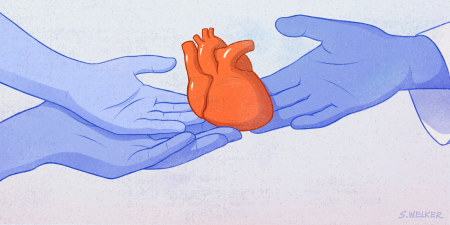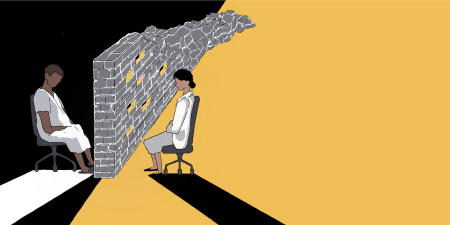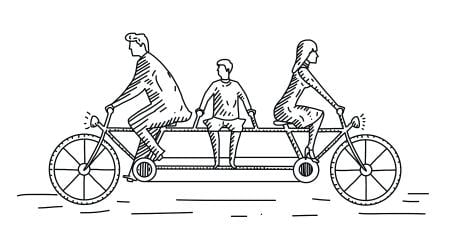Abstract
Illness and injury often entail lasting health and social consequences beyond the acute event. During the immediate and long-term recovery period, consequences of illness or injury can often be mitigated and addressed. As patients and their clinicians discuss care decisions, whether for initial or ongoing management of illness or injury, they must consider patients’ personal goals of recovery alongside possible clinical outcomes to choose the best path forward. Understanding the recovery process and patients’ and clinicians’ decision making requires clarifying the concept of recovery and its significance. This article will describe how shared decision making can support the recovery process using a case example of brachial plexus injury.
Case
Ms M is a 32-year-old, right-hand-dominant engineer who developed weakness, numbness, and shooting pain through her right shoulder and arm 3 months ago, following a fall from a bicycle during a recent vacation. She cannot raise her arm overhead and cannot flex her elbow. Her symptoms are consistent with an injury to the brachial plexus (the network of nerves that connect the spinal cord to the muscles and skin of the shoulder, arm, and hand), which can manifest as weakness or absence of muscle function, loss of sensation, or shooting pain. Nerve regeneration is a lengthy process and many patients experience emotional distress, financial strain, and increased reliance on others during the prolonged recovery.1,2,3
Due to concern for a brachial plexus injury (BPI), Ms M’s primary care physician referred her to a peripheral nerve surgeon, Dr D, whom she has been seeing in follow-up for her diagnosis of BPI (attributed to a stretch injury to the nerves sustained in the fall). As is standard of care, Ms M did not receive immediate posttraumatic intervention but has had close monitoring of her motor function, which has unfortunately demonstrated only modest return of function. Dr D counseled her that many patients with her injury (an upper trunk BPI) recover nearly full strength with observation,4 and those who do so typically start to see signs of muscle reinnervation by 3 to 6 months.5 However, some patients do not have recovery of muscle innervation and may benefit from reconstructive surgery (eg, nerve transfer). At this point in her recovery (3 months from her injury), early intervention with surgery is a viable option, although it remains unknown whether Ms M would spontaneously regain further function over the coming months. Dr D and Ms M begin a discussion about the choice for early surgery vs continued monitoring, given the considerations involved.
Commentary
As patients and their clinicians discuss care decisions, whether for initial or ongoing management of illness or injury, they must consider patients’ personal goals of recovery alongside possible clinical outcomes to choose the best path forward. We consider recovery to capture the notion of healing at its most basic level. From a theoretical perspective, Atterbury has suggested that recovery-oriented care entails holistic preservation of the self: “Embedded in a recovery orientation is the understanding that service users [patients] are experts in their own experience, that a diagnosis cannot capture the totality of a person’s being, and that effective and ethical interventions recognize the full personhood and rights of service-users [patients].”6 Similarly, empirical research on recovery from illness or injury has produced valuable insight into patients’ perceptions of recovery. Patients’ goals of recovery include common themes of restored function, comfort, and a global sense of normalcy.7,8,9,10 The individual nature of patient recovery goals and priorities sometimes differ from those of clinicians.7
Clinical outcomes during recovery suggest that recovery is an ongoing process, wherein goals (such as functional status) may be attained temporarily and change dynamically over the course of the recovery period.11 Patient and clinician perspectives on and discussions about the recovery process and its implications for patient care should be informed by a shared decision-making (SDM) approach. Understanding the recovery process and patients’ and clinicians’ decision making requires clarifying the concept of recovery and its significance.
Recovery Planning
SDM is a collaborative process through which patients and clinicians contribute unique perspectives to discussion of care options and aim to achieve consensus by considering medical evidence alongside patient preferences.12,13 When there are reasonable alternative courses of care and time to deliberate on them, SDM can be seen as the ideal of patient-centered medicine.14 Engaging in SDM during illness recovery requires navigating the unique considerations present throughout the recovery process. Prognoses can evolve, and patients’ desired outcomes and the feasibility of achieving those outcomes might shift over time, requiring a reevaluation of recovery goals.
Patients often place a higher priority than clinicians on subjective experiences of illnesses.
BPI provides an excellent example of how SDM can facilitate recovery planning. The physiologic and functional consequences of BPI are significant and measurable (and so can be recognized and tracked by both patients and clinicians),15,16 the optimal course of management is uncertain, and the alternative options (waiting vs surgery) are substantially different. Surgery may offer better long-term function and predictable results, but it is invasive, carries some risks, and entails postoperative immobilization, physical therapy, and a total rehabilitative course lasting up to a year or more.5 Continued observation carries the risk of additional muscle atrophy, less reliable results, and prolonged loss of productivity. Early surgical intervention is of uncertain value compared to continued waiting and later surgery,17 and the timing of surgery also involves social-logistical considerations, such as availability of time off from work, coverage of other responsibilities, and personal assistance in the postoperative period. We can explore the use of SDM in this case by considering the perspectives that Ms M and Dr D might bring to the clinical decision (see Table 1).
| Options | ||
|---|---|---|
|
Perspective |
Continued Observation | Early Surgical Reconstruction |
| Ms M (patient) |
|
|
| Dr D (surgeon) |
|
|
In what follows, we use a framework of SDM that includes team talk (defining recovery, considering patients’ preferences), option talk (identifying feasible outcomes, discussing their pros and cons), and decision talk (discussing patient preferences regarding the pros and cons of options, planning next steps) (see Table 2).
| Domaina | Goals | Clinician Communication |
|---|---|---|
| Defining Recovery (Team Talk) |
|
|
|
|
|
| Options, Outcomes, and Odds (Option Talk) |
|
|
|
|
|
|
|
|
| Recovery Planning (Decision Talk) |
|
|
|
|
|
|
a Based on Elwyn et al.13
|
||
Perspectives on the SDM process. Clinicians’ perspectives on recovery may be informed by their professional context. As products of training curricula based in science, physicians such as Dr D might implicitly prefer the apparent objectivity of quantifiable and clinical measures for tracking recovery (eg, electromyography or nerve conduction studies) over qualitative or patient-reported quality-of-life assessments. Such preferences may even be explicit when the available research studies use the same measures to evaluate clinical success.
The experience of life after illness and injury can be contextualized (by both patients and clinicians) in terms of deviations from a patient’s baseline status prior to illness or injury—deviations that may span activities of daily living, recreational and occupational activities, and elements of quality of life, such as mood and pain or other discomfort. In the case of BPI, comparative prognostic information can be constrained by the limited and variable nature of outcomes reporting (predominantly pure motor function) in studies of reconstructive surgery.18 Thus, in discussing surgery decisions with Ms M, Dr D is limited to his own clinical experience (and that of colleagues), the direct evidence provided by outcomes data in the literature, and the extent to which these data pertain to patient-relevant functional improvements.19
Although clinicians might understand and consider patients’ subjective experiences of illness and injury, patients often place a higher priority than clinicians on these experiences. For patients, the social and emotional contexts of health consequences are especially salient and intersect with integral concepts such as independence, confidence, and social or family roles.7,9 These differences in perspective offer insight into the approaches that patients and clinicians take in evaluating alternative paths to recovery. In the present case, the choice characteristics most meaningful to Ms M could differ from those most meaningful to Dr D (see Table 1).
Contributions to the SDM process. In general, clinicians’ contributions to SDM include clinical expertise (eg, epidemiological, pathophysiological, and other knowledge), the ability to communicate such information effectively, and shared deliberation with patients. For procedural interventions, surgeons like Dr D also bring relevant insight based on their own experience and technical skill, which should inform their assessment of options and might also inform patient expectations. In addition to experiential knowledge of symptoms and functional impairment, patients contribute the value—the importance and priority—they place upon aspects of life relevant to the care decision. Exploring and clarifying these values is an essential element of SDM, as it informs the determination of patients’ priorities and preferences for care options and their potential outcomes. In the case example, SDM requires identifying the ways in which Ms M’s injury has meaningfully impacted her daily life and clarifying her values with respect to these impacts. For example, Ms M might currently be able to continue working despite her dominant arm weakness, but she may have difficulty with socially meaningful tasks such as driving or caring for children. Each impact can have a different personal significance for her (see Table 1).
Responsibilities in the SDM process. In order to appropriately support deliberation among options, clinicians must aid patients in identifying and prioritizing their goals for recovery. In Ms M’s case, it might be helpful to explicitly ask her to consider what would constitute recovery for her.8 Clinicians should facilitate deliberation through concrete examples. For example, Dr D might address the goal of functional capability by asking Ms M to identify the impaired tasks she finds most important to master through rehabilitation. He might ask what typical pain severity level Ms M would find tolerable and what behavioral modifications or medications she would be comfortable trying in order to achieve improvement. Clinicians are also responsible for being familiar with estimates of outcomes (when available), evaluating the applicability of these population-based estimates to the patient, and communicating them effectively at each patient’s level of comfort with numbers. This responsibility derives from the clinician’s duty to their patient’s best interest: the most complete and accurate information for each patient should be identified, just as it should be conveyed to each patient as clearly and accurately as possible.
Although Ms M works as an engineer and likely has high numeracy (ability to understand numeric information), Dr D should take care to use best practices in quantitative risk communication: presentation of absolute risks and risk differences (rather than relative measures), use of whole numbers to describe probabilities (natural frequencies), and use of consistent scales for event rates (same-denominator comparisons).20,21 To aid communication of this technical information, clinicians can leverage appropriate communication tools such as visual aids, especially when such formal decision aids exist for the clinical choice in question. At the same time, clinicians must acknowledge the uncertainty inherent in prognostication and attempt to help patients find comfort with the unknown. Clinicians should have a basic understanding of processes that can impact patient reasoning, such as anticipatory regret (the level of guilt or negative feeling one might experience about a potential outcome, regardless of its likelihood of occurring) and affective forecasting errors (errors in predicting how one might feel in the future).22 Clinicians should use this knowledge to promote productive patient deliberation by probing patients’ reasoning (“Tell me more about why you are leaning toward this option”) and providing additional perspectives for reflection. Additionally, successful SDM requires patients to engage thoughtfully in the process by identifying and communicating their values and goals and asking any questions they have about the information the clinician provides.
Conclusion
Successful SDM occurs when patients and clinicians fulfill their responsibilities to create a shared concept of recovery that both optimizes clinical outcomes and is informed by patient preferences and goals. Throughout the recovery process, progress or setbacks that inform the patient’s prospects may necessitate reevaluation of realistic recovery goals. Although ideal outcomes cannot be expected in every case, involving patients in SDM can make the most of their recovery experience and provide them the best chance at choosing a recovery path that meets both their clinical and their personal needs.
References
- Yannascoli SM, Stwalley D, Saeed MJ, Olsen MA, Dy CJ. A population-based assessment of depression and anxiety in patients with brachial plexus injuries. J Hand Surg. 2018;43(12):113.e1-1136.e9.
- Morris MT, Daluiski A, Dy CJ. A thematic analysis of online discussion boards for brachial plexus injury. J Hand Surg. 2016;41(8):813-818.
-
Hong TS, Tian A, Sachar R, Ray WZ, Brogan DM, Dy CJ. Indirect cost of traumatic brachial plexus injuries in the United States. J Bone Joint Surg Am. 2019;101(16):e80.
- Midha R. Epidemiology of brachial plexus injuries in a multitrauma population. Neurosurgery. 1997;40(6):1182-1189.
- Noland SS, Bishop AT, Spinner RJ, Shin AY. Adult traumatic brachial plexus injuries. J Am Acad Orthop Surg. 2019;27(19):705-716.
- Atterbury K. Preserving the person: the ethical imperative of recovery-oriented practices. Am J Orthopsychiatry. 2014;84(2):182-189.
- Aitken LM, Chaboyer W, Jeffrey C, et al. Indicators of injury recovery identified by patients, family members and clinicians. Injury. 2016;47(12):2655-2663.
- Carroll LJ, Lis A, Weiser S, Torti J. How well do you expect to recover, and what does recovery mean, anyway? Qualitative study of expectations after a musculoskeletal injury. Phys Ther. 2016;96(6):797-807.
- Claydon JH, Robinson L, Aldridge SE. Patients’ perceptions of repair, rehabilitation and recovery after major orthopaedic trauma: a qualitative study. Physiotherapy. 2017;103(3):322-329.
-
Sims-Gould J, Stott-Eveneshen S, Fleig L, McAllister M, Ashe MC. Patient perspectives on engagement in recovery after hip fracture: a qualitative study. J Aging Res. 2017;2017:2171865.
-
Harcombe H, Langley J, Davie G, Derrett S. Functional status following injury: what recovery pathways do people follow? Injury. 2015;46(7):1275-1280.
- Hoffmann TC, Montori VM, Del Mar C. The connection between evidence-based medicine and shared decision making. JAMA. 2014;312(13):1295-1296.
-
Elwyn G, Durand MA, Song J, et al. A three-talk model for shared decision making: multistage consultation process. BMJ. 2017;359:j4891.
- Barry MJ, Edgman-Levitan S. Shared decision making—the pinnacle of patient-centered care. N Engl J Med. 2012;366(9):780-781.
- Bengtson KA, Spinner RJ, Bishop AT, et al. Measuring outcomes in adult brachial plexus reconstruction. Hand Clin. 2008;24(4):401-415.
- Landers ZA, Jethanandani R, Lee SK, Mancuso CA, Seehaus M, Wolfe SW. The psychological impact of adult traumatic brachial plexus injury. J Hand Surg. 2018;43(10):950.ei-950.e6.
-
Dy CJ, Brogan DM. Adult brachial plexus injury reconstruction. In: Weiss APC, ed. Textbook of Hand and Upper Extremity Surgery. 2nd ed. Chicago, IL: American Society for Surgery of the Hand; 2019:1-42.
- Dy CJ, Garg R, Lee SK, Tow P, Mancuso CA, Wolfe SW. A systematic review of outcomes reporting for brachial plexus reconstruction. J Hand Surg. 2015;40(2):308-313.
- Ferreira SR, Martins RS, Siqueira MG. Correlation between motor function recovery and daily living activity outcomes after brachial plexus surgery. Arq Neuropsiquiatr. 2017;75(9):631-634.
- Fagerlin A, Zikmund-Fisher BJ, Ubel PA. Helping patients decide: ten steps to better risk communication. J Natl Cancer Inst. 2011;103(19):1436-1443.
- Zikmund-Fisher BJ. Time to retire the 1-in-X risk format. Med Decis Making. 2011;31(5):703-704.
- Gornick MC, Zikmund-Fisher BJ. What clinical ethics can learn from decision science. AMA J Ethics. 2019;21(10):906-912.



